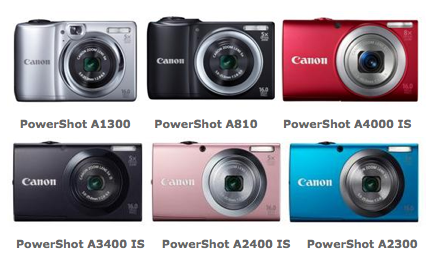It is only a rumour, but there are suggestions that Canon will soon cease production of lower-end, sub-$200 point-and-shoot cameras. Given the steady erosion of compact camera sales and their inability to compete against the convenience and ubiquity of the smartphone, it's hardly surprising. It's also a step taken already by Olympus by Fujifilm. And just as we stated in the cases of both Olympus and Fujifilm, this is a good thing. By my count since January 2012, Canon has released twelve IXUS model cameras and ten Powershot A-series cameras. These are typically regarded as its cheaper and cheerier models. They tend to range between £80 and £180, although the odd few come in much higher than that, have more than enough megapixels to keep the pushiest salesperson smiling, a decent optical zoom range, the ability to record video, and sometimes are blessed with image stabilisation. Unlike Canon's dSLR range, which comprises a controlled range of cameras with clear spec expectations at given price-points, it's verging on the impossible to discern one compact model from another. Their variations in spec are so slender that they all merge into one rainbow-coloured haze.

Herein is their downfall. First, they're not something that you'd go out to buy when you have a wirelessly connected smartphone in your pocket. There's not really enough value-added to justify the outlay. Second: when there are so many different cameras with so little to differentiate one from another, it's little wonder that consumers' eyes glaze over and they decide to stick with what they now know: their iPhones and their Samsung Galaxys. Choice is a good thing, but sometimes offering too much choice, without making obvious why it's needed, is self-defeating.
Let's not forget, that little tot-up of cameras didn't include any of Canon's Powershot SX range, which covers the superzooms, its D-series rugged cameras, the S- and G-series, which are its high-end compacts, and the quite-frankly-ridiculous N-series.
If anything can convince you that Canon really ought give up on the definitely-fled smartphone crowd, it's the N-series of cameras. They smacked of desperation, of designers under pressure to produce something 'young and funky and with-it' in an attempt to recapture a market long since gone, and engineers who'd rather be working on any other project than that one. Yes, they are out of the 'sub-$200' bracket of cameras that are expected to be axed, but they have no place in the range, either.
By relieving itself of the burden of the cheap end of the compact camera spectrum, Canon can refocus its attentions on the areas where there is hope, where there is potential, where there really is a market. Most definitely on its dSLRs, that seem to have gone off of the boil ever so slightly of late. Perhaps on its higher-end compact cameras, which are still selling and I believe show that compacts do still have a place in the canon of cameras, but could benefit from some innovation and development. And maybe even in the mirror-less division, where the EOS M has been so painfully disappointing.
This shouldn't be regarded as a move of panic or despair on Canon's part. I actually think it's rather mature. It shows how it might be beginning to analyse the market, to identify its strengths and weaknesses, and to come to terms with the idea of an evolving photography world.
